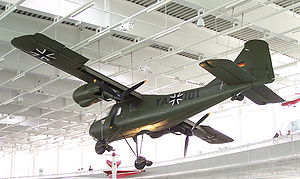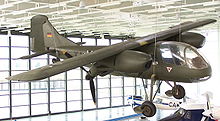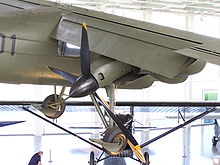Dornier Do 29 Video - Picture

|
|
Dornier Do 29
Do 29

Picture - Do 29 on display at the Dornier Museum
Role: Experimental aircraft
National origin: Germany
Manufacturer: Dornier Flugzeugwerke
First flight: 12 December 1958
Primary user: DFL
Produced: 2
Developed from: Dornier Do 27
The Dornier Do 29 was an experimental aircraft developed by Dornier Flugzeugwerke and the Deutsche Versuchsanstalt fx¼r Luftfahrt (German Aviation Laboratory) in the 1950s, used to test a tilting-propeller system for short takeoff and landing aircraft. The concept was proved to be successful in flight testing, however no further development of the system or aircraft was proceeded with, and at the conclusion of its test program the Do 29 was retired.
Design and development
During the Second World War, Heinrich Focke of Focke-Achgelis, a manufacturer of helicopters, developed a design for a short-takeoff-and-landing (STOL) aircraft that would utilise a system of pusher propellers, one on each wing in a pusher configuration, to provide downwards thrust and enhance lift. Designated Fa 269, the design was not developed due to the state of the war.
In the 1950s, however, a renewed interest in STOL and VTOL aircraft led to a re-evaluation of Focke's concept, and Dornier was given a contract to develop an aircraft capable of demonstrating the tilting-propeller system. The aircraft, given the designation Do 29, was based on the Do 27 light transport, modified with twin Lycoming GO-480 engines mounted below the wings. These engines drove three-bladed, pusher propellers, that were capable of being tilted downwards to an angle of up to 90 degrees, and the engines were coupled so that symmetrical thrust could be maintained in the event of an engine failure.
The forward fuselage was also modified with a helicopter-like cockpit. A Martin-Baker ejection seat was provided for pilot escape in the event of a crash.
Testing

Picture - The Do 29 at the Dornier Museum
Two examples of the Do 29 were constructed, while a third was planned but not built, with the first protoype flying on 12 December 1958. In the following flight testing, the propeller system was not rotated further than 60 degrees as opposed to its nominal 90 degree capability, but the aircraft proved to be highly successful, with a stalling speed of 24 kilometres per hour (15 mph) and exceptional short-field performance.
Despite this, however, the tilting-propeller system was not further pursued after the end of the flight test program.
Aircraft on display
One of the Do 29 prototypes survived the program, and is displayed in the Dornier Museum in Germany.
Specifications (Do 29)

Picture - Detail of propeller assembly
Data from
General characteristics
Crew: 1 (pilot)
Length: 9.5 m (31 ft 2 in)
Wingspan: 13.2 m (43 ft 4 in)
Height: 2.69 m (8 ft 10 in)
Wing area: 21.8 m (235 sq ft)
Gross weight: 2,400 kg (5,291 lb)
Max takeoff weight: 2,500 kg (5,512 lb)
Powerplant: 2 x— Lycoming GO-480-B1A6 geared opposed piston engines, 200 kW (270 hp) each
Propellers: 3-bladed
Performance
Maximum speed: 290 km/h (180 mph; 160 kn)
Minimum control speed: 24 km/h (15 mph; 13 kn)
Range: 400 km (249 mi; 216 nmi)
Service ceiling: 6,500 m (21,325 ft)
Comparable aircraft
Ryan VZ-3
Bibliography
Green, William. Observer's book of aircraft (1960 ed.). London: Frederick Warne & Co. Ltd..
Winchester, Jim, ed. Aviation Factfile: Concept Aircraft. San Diego, CA: Thunder Bay Press. ISBN 1-59223-480-1
Dornier Do 29 Pictures
More aircraft.
Source: WikiPedia